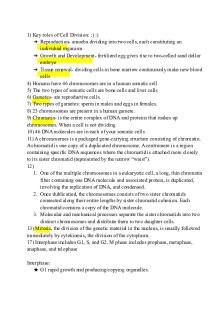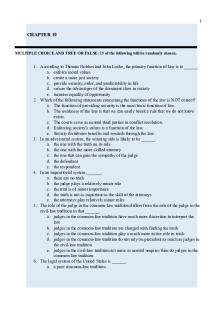14. POLS 301 Wk 5 Chapter 12 Quiz 12 Study Guide PDF

| Title | 14. POLS 301 Wk 5 Chapter 12 Quiz 12 Study Guide |
|---|---|
| Course | Introduction to Government: United States |
| Institution | Sacramento City College |
| Pages | 5 |
| File Size | 109.5 KB |
| File Type | |
| Total Downloads | 96 |
| Total Views | 147 |
Summary
Quiz Study Guide...
Description
1
CHAPTER 12
MULTIPLE CHOICE AND TRUE OR FALSE: 15 of the following will be randomly chosen.
1. Political gridlock occurs when ______. a. too many individuals from opposing political parties agree on an issue, thereby doing away with political diversity b. rival parties stubbornly refuse to budge from their positions to achieve a compromise in the public interest c. too many bills are waiting to be passed because Congress is not in session d. incumbents keep getting reelected e. no incumbents get reelected 2. Parties help to overcome the problem of ______ created by the Constitution. a. the threat of tyranny b. an overly powerful national government c. overly powerful state governments d. a weak national government e. fragmented government 3. All of the following statements concerning party identification in the electorate are true EXCEPT this one: a. Most people who are registered members of a party work actively for their party organization. b. Most voters who identify with a party identify with the same party as their parents. c. The percentage of the electorate identifying themselves as independents grew substantially in the 1970s and 1980s. d. Most people who identify with a party regularly vote for that party in elections. e. The percentage of voters identifying with the Democratic Party has dropped significantly from its high in the 1950s. 4. The responsible party model ______. a. weakens the link between voters and officials b. makes it easier for voters to hold parties accountable for their actions c. causes campaigns to be less negative d. makes legislatures less divisive e. decreases political efficacy 5. The argument for the responsible party model is that democracy is strengthened when ______. a. voters are given clear alternatives and hold parties responsible for their promises b. politicians have the flexibility to take individual positions on issues, regardless of their party c. voters vote for the candidate, not the party
2
6.
7.
8.
9.
d. there are only two parties e. the character of the candidates is more important than their policy positions The party ______ are the members of a political party who consistently vote for that party’s candidates. a. base b. organization c. core d. factions e. platform Which of the following is NOT a characteristic of the responsible party model? a. Each party should present a coherent set of programs to the voters, consistent with its ideology and clearly different from those of the other party. b. The candidates for each party should pledge to support their party’s platform and to implement their party’s program if elected. c. Voters should make their choices based on which party’s program most closely reflects their own ideas and hold the parties responsible for unkept promises by voting their members out of office. d. While governing, each party should exercise control over its elected officials to ensure that party officials are promoting and voting for its programs, thereby providing accountability to the voters. e. Each party should act in a polarized fashion to such an extent that their behavior impedes government functions. Which of the following is NOT true regarding issue positions of the major parties? a. Democrats want “more services” over “cutting government spending.” b. Democrats are more likely than Republicans to advocate for gun control and reasonable regulation c. Republicans are more likely than Democrats to oppose abortion. d. Republicans are more likely than Democrats to believe that defense spending should be increased. e. Democrats are more likely than Republicans to believe that government should let each person get ahead on his or her own rather than guaranteeing jobs and standards of living. Since the 1960s, ______. a. Republicans and Democrats have become more consistent with respect to their ideologies b. both Republicans and Democrats have become more conservative c. southern Democrats have grown in number, making the Democratic Party more liberal d. both Republicans and Democrats have leaned liberal e. the Republican Party has been much less consistent than the Democratic Party with respect to ideology
3
10. The Democratic Party has become more liberal and the Republican Party more conservative because of the ______. a. movement of conservative New Englanders and New Yorkers into the Republican Party b. growing influence of the Republican Party in the industrial Midwest c. growth of Democratic influence with liberals of the Rocky Mountain area d. movement of conservative, southern Democrats to the Republican Party e. growing influence of the Democratic Party in the West 11. Parties appeal to moderate voters by doing all of the following EXCEPT this: a. publicly denouncing the more extreme wing of their own party b. not publicly endorsing positions they may like but know that moderates reject c. emphasizing issues they know are popular with moderates d. reframing issues in ways that are more palatable to voters e. changing positions that have been rejected by moderates 12. The party that usually gets the most votes is the party that ______. a. best appeals to moderate voters b. best appeals to its base c. has the most innovative program d. appeals to a mix of conservative and liberal voters e. mobilizes the most conservative voters 13. The rank-and-file members who carry out the party’s electioneering efforts are the ______. a. party activists b. party-in-the-electorate c. party delegates d. party bosses e. party radicals 14. Party activists are important to the parties for all of the following reasons EXCEPT this one: a. They provide the base of votes from which candidates build majorities to win elections. b. They are able to exert power over the nomination of candidates. c. They force potential candidates to take issue positions consistent with their beliefs. d. They are the source of the drive to capture moderate voters and win elections. e. They put pressure on members of the party in Congress to vote on the basis of the party’s ideology. 15. Which of the following questions is NOT one that needs to be asked by a critical reader of party platforms? a. Whose platform is it, and what do you know about that party’s basic political positions? b. Do public opinions polls show this party’s platform was the one supported by the voters at the time it was written?
4
c. Who is the audience? d. What statements reflect values, and which are statements of fact? e. What is your reaction to the platform? 16. Why would the two American parties feel the need to take more extreme issue positions? a. because more extreme positions on issues will be more likely to receive press coverage b. because most general election voters hold extreme positions on issues c. to usurp support for third parties d. to satisfy the party activists e. so that they don’t appear to flip-flop on issues 17. The major source of money for party fundraisers comes from ______. a. individual donors b. economic interest groups c. individual donors and party officials d. public interest groups e. foreign donors and public interest groups 18. The statement that third parties are irrelevant in modern-day politics is ______. a. truer than ever in today’s political landscape b. less accurate than in the past due to the Tea Party victories of the 2010 midterm elections c. false and has always been false d. has only ever applied to Europe e. none of the above 19. Primary voters, party activists, and big-money donors ______. a. tend to push for more moderate candidates in primaries so that they will have a better chance of winning the general election b. make up the party organization c. tend to be more ideological and issue oriented than the voters in the general election d. are less likely than independent voters to vote e. work for party bosses 20. According to James Madison, political parties were ______. a. the organizations that would link citizens to government b. a dangerous version of factions c. not likely to become influential until after the writers of the Constitution died d. the organizations that would potentially develop policy agendas for the new American democracy e. unlikely to become influential in American politics 21. All of the following statements concerning party machines are true EXCEPT this one: a. Their goal was to take advantage of the expansion of voting rights to all white men in the early nineteenth century. b. Their activities had the consequence of integrating masses of new immigrants into the political process.
5
c. They were characterized by central control by a party leader or boss. d. They dominated party primary elections. e. They were exceptionally strong in urban areas. 22. The system in which successful party candidates reward supporters with jobs or favors is called ______. a. the civil service system b. patronage c. the party machine d. electioneering e. party benefits 23. In a(n) _______, registered party members, rather than party bosses, nominate party candidates. a. straw poll b. referendum c. party primary d. general party election e. initiative 24. Which of the following statement is NOT true regarding party machines? a. Party machines were strongest in rural areas. b. Party machines guaranteed people’s support through patronage. c. Party machines came under attack from reformers in the early 1900s. d. Party bosses had complete control over the nomination process. e. Party machines originated with the Jacksonian Democrats. 25. Patronage was once important to political parties because ______. a. it created a more disciplined party-in-government b. it ensured an army of supporters and workers for elections c. it created a stronger party organization d. it simplified the issue of hiring people after an election e. members of the other party would be unemployed...
Similar Free PDFs

Quiz 12 Study Guide
- 2 Pages

Chapter 12 Study Guide
- 4 Pages

Study Guide Chapter 12
- 3 Pages

Study Guide Chapter 12
- 2 Pages

Wk 10 - Study Guide Quiz 5
- 7 Pages

AP -Chapter 12 study guide
- 39 Pages

Chapter 12 6e study guide
- 8 Pages

Chapter 12 Mitosis Study Guide
- 4 Pages
Popular Institutions
- Tinajero National High School - Annex
- Politeknik Caltex Riau
- Yokohama City University
- SGT University
- University of Al-Qadisiyah
- Divine Word College of Vigan
- Techniek College Rotterdam
- Universidade de Santiago
- Universiti Teknologi MARA Cawangan Johor Kampus Pasir Gudang
- Poltekkes Kemenkes Yogyakarta
- Baguio City National High School
- Colegio san marcos
- preparatoria uno
- Centro de Bachillerato Tecnológico Industrial y de Servicios No. 107
- Dalian Maritime University
- Quang Trung Secondary School
- Colegio Tecnológico en Informática
- Corporación Regional de Educación Superior
- Grupo CEDVA
- Dar Al Uloom University
- Centro de Estudios Preuniversitarios de la Universidad Nacional de Ingeniería
- 上智大学
- Aakash International School, Nuna Majara
- San Felipe Neri Catholic School
- Kang Chiao International School - New Taipei City
- Misamis Occidental National High School
- Institución Educativa Escuela Normal Juan Ladrilleros
- Kolehiyo ng Pantukan
- Batanes State College
- Instituto Continental
- Sekolah Menengah Kejuruan Kesehatan Kaltara (Tarakan)
- Colegio de La Inmaculada Concepcion - Cebu







